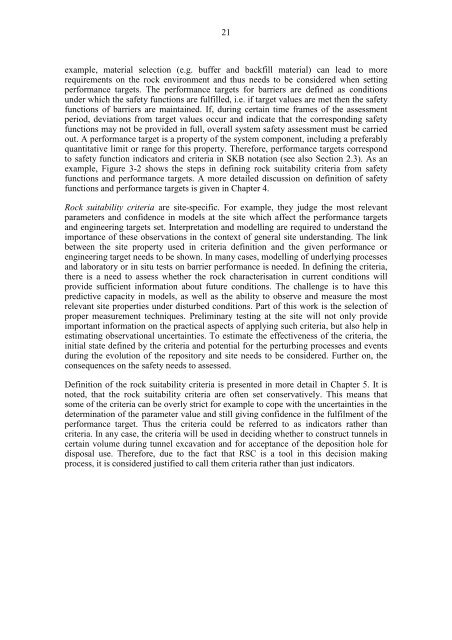RSC-Programme - Interim Report. Approach and Basis for - Posiva
RSC-Programme - Interim Report. Approach and Basis for - Posiva
RSC-Programme - Interim Report. Approach and Basis for - Posiva
You also want an ePaper? Increase the reach of your titles
YUMPU automatically turns print PDFs into web optimized ePapers that Google loves.
21example, material selection (e.g. buffer <strong>and</strong> backfill material) can lead to morerequirements on the rock environment <strong>and</strong> thus needs to be considered when settingper<strong>for</strong>mance targets. The per<strong>for</strong>mance targets <strong>for</strong> barriers are defined as conditionsunder which the safety functions are fulfilled, i.e. if target values are met then the safetyfunctions of barriers are maintained. If, during certain time frames of the assessmentperiod, deviations from target values occur <strong>and</strong> indicate that the corresponding safetyfunctions may not be provided in full, overall system safety assessment must be carriedout. A per<strong>for</strong>mance target is a property of the system component, including a preferablyquantitative limit or range <strong>for</strong> this property. There<strong>for</strong>e, per<strong>for</strong>mance targets correspondto safety function indicators <strong>and</strong> criteria in SKB notation (see also Section 2.3). As anexample, Figure 3-2 shows the steps in defining rock suitability criteria from safetyfunctions <strong>and</strong> per<strong>for</strong>mance targets. A more detailed discussion on definition of safetyfunctions <strong>and</strong> per<strong>for</strong>mance targets is given in Chapter 4.Rock suitability criteria are site-specific. For example, they judge the most relevantparameters <strong>and</strong> confidence in models at the site which affect the per<strong>for</strong>mance targets<strong>and</strong> engineering targets set. Interpretation <strong>and</strong> modelling are required to underst<strong>and</strong> theimportance of these observations in the context of general site underst<strong>and</strong>ing. The linkbetween the site property used in criteria definition <strong>and</strong> the given per<strong>for</strong>mance orengineering target needs to be shown. In many cases, modelling of underlying processes<strong>and</strong> laboratory or in situ tests on barrier per<strong>for</strong>mance is needed. In defining the criteria,there is a need to assess whether the rock characterisation in current conditions willprovide sufficient in<strong>for</strong>mation about future conditions. The challenge is to have thispredictive capacity in models, as well as the ability to observe <strong>and</strong> measure the mostrelevant site properties under disturbed conditions. Part of this work is the selection ofproper measurement techniques. Preliminary testing at the site will not only provideimportant in<strong>for</strong>mation on the practical aspects of applying such criteria, but also help inestimating observational uncertainties. To estimate the effectiveness of the criteria, theinitial state defined by the criteria <strong>and</strong> potential <strong>for</strong> the perturbing processes <strong>and</strong> eventsduring the evolution of the repository <strong>and</strong> site needs to be considered. Further on, theconsequences on the safety needs to assessed.Definition of the rock suitability criteria is presented in more detail in Chapter 5. It isnoted, that the rock suitability criteria are often set conservatively. This means thatsome of the criteria can be overly strict <strong>for</strong> example to cope with the uncertainties in thedetermination of the parameter value <strong>and</strong> still giving confidence in the fulfilment of theper<strong>for</strong>mance target. Thus the criteria could be referred to as indicators rather thancriteria. In any case, the criteria will be used in deciding whether to construct tunnels incertain volume during tunnel excavation <strong>and</strong> <strong>for</strong> acceptance of the deposition hole <strong>for</strong>disposal use. There<strong>for</strong>e, due to the fact that <strong>RSC</strong> is a tool in this decision makingprocess, it is considered justified to call them criteria rather than just indicators.
















